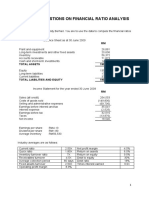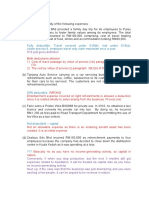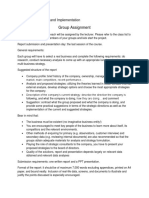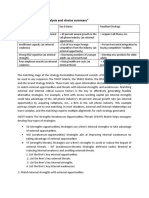0 ratings0% found this document useful (0 votes)
256 viewsStrategic Implementation ASSIGNMENT
Strategic Implementation ASSIGNMENT
Uploaded by
jeyaprakashaaryanStrategic implementation is critical for a company's success and involves assigning tasks, timelines, and leaders to help the organization reach its goals and objectives. A successful implementation plan will have visible leadership from the CEO to communicate the vision and engage the entire organization. Performance measurement tools provide motivation and allow for progress tracking. Implementation often includes a strategic map that identifies key factors like finances, market, operations, people, and partners that will direct performance.
Copyright:
© All Rights Reserved
Available Formats
Download as DOCX, PDF, TXT or read online from Scribd
Strategic Implementation ASSIGNMENT
Strategic Implementation ASSIGNMENT
Uploaded by
jeyaprakashaaryan0 ratings0% found this document useful (0 votes)
256 views7 pagesStrategic implementation is critical for a company's success and involves assigning tasks, timelines, and leaders to help the organization reach its goals and objectives. A successful implementation plan will have visible leadership from the CEO to communicate the vision and engage the entire organization. Performance measurement tools provide motivation and allow for progress tracking. Implementation often includes a strategic map that identifies key factors like finances, market, operations, people, and partners that will direct performance.
Original Description:
Strategic implementation
Copyright
© © All Rights Reserved
Available Formats
DOCX, PDF, TXT or read online from Scribd
Share this document
Did you find this document useful?
Is this content inappropriate?
Strategic implementation is critical for a company's success and involves assigning tasks, timelines, and leaders to help the organization reach its goals and objectives. A successful implementation plan will have visible leadership from the CEO to communicate the vision and engage the entire organization. Performance measurement tools provide motivation and allow for progress tracking. Implementation often includes a strategic map that identifies key factors like finances, market, operations, people, and partners that will direct performance.
Copyright:
© All Rights Reserved
Available Formats
Download as DOCX, PDF, TXT or read online from Scribd
Download as docx, pdf, or txt
0 ratings0% found this document useful (0 votes)
256 views7 pagesStrategic Implementation ASSIGNMENT
Strategic Implementation ASSIGNMENT
Uploaded by
jeyaprakashaaryanStrategic implementation is critical for a company's success and involves assigning tasks, timelines, and leaders to help the organization reach its goals and objectives. A successful implementation plan will have visible leadership from the CEO to communicate the vision and engage the entire organization. Performance measurement tools provide motivation and allow for progress tracking. Implementation often includes a strategic map that identifies key factors like finances, market, operations, people, and partners that will direct performance.
Copyright:
© All Rights Reserved
Available Formats
Download as DOCX, PDF, TXT or read online from Scribd
Download as docx, pdf, or txt
You are on page 1of 7
Strategic Implementation Addresses
Strategic implementation is critical to a company’s success,
addressing the who, where, when, and how of reaching the
desired goals and objectives. It focuses on the entire
organization. Implementation occurs after environmental scans,
SWOT analyses, and identifying strategic issues and goals.
Implementation involves assigning individuals to tasks and
timelines that will help an organization reach its goals .
Basic Features
A successful implementation plan will have a very visible
leader, such as the CEO, as he communicates the vision,
excitement and behaviors necessary for achievement. Everyone
in the organization should be engaged in the plan. Performance
measurement tools are helpful to provide motivation and allow
for follow up. Implementation often includes a strategic map,
which identifies and maps the key ingredients that will direct
performance. Such ingredients include finances, market, work
environment, operations, people and partners.
Definition:
Strategy Implementation refers to the execution of the
plans and strategies, so as to accomplish the long-term goals of
the organization. It converts the opted strategy into the moves
and actions of the organization to achieve the objectives . Simply
put, strategy implementation is the technique through which the
firm develops, utilizes and integrates its structure, culture,
resources, people and control system to follow the strategies to
have the edge over other competitors in the market.
Process of Strategy Implementation
1. Building an organization, that possess the capability to put the
strategies into action successfully.
2. Supplying resources, in sufficient quantity, to strategy-
essential activities.
3. Developing policies which encourage strategy.
4. Such policies and programs are employed which helps in
continuous improvement.
5. Combining the reward structure, for achieving the results.
6. Using strategic leadership.
The process of strategy implementation has an important role to
play in the company’s success. The process takes places after
environmental scanning, SWOT analyses and ascertaining the
strategic issues.
Prerequisites of Strategy Implementation
Institutionalization of Strategy: First of all the
strategy is to be institutionalized, in the sense that the
one who framed it should promote or defend it in front of
the members, because it may be undermined.
Developing proper organizational climate:
Organizational climate implies the components of the
internal environment, that includes the cooperation,
development of personnel, the degree of commitment
and determination, efficiency, etc., which converts the
purpose into results.
Formulation of operating plans: Operating plans refers to
the action plans, decisions and the programs, that take place
regularly, in different parts of the company. If they are framed
to indicate the proposed strategic results, they assist in
attaining the objectives of the organization by concentrating
on the factors which are significant.
Developing proper organisational structure:
Organization structure implies the way in which different parts
of the organisation are linked together. It highlights the
relationships between various designations, positions and
roles. To implement a strategy, the structure is to be designed
as per the requirements of the strategy.
Periodic Review of Strategy: Review of the strategy is to
be taken at regular intervals so as to identify whether the
strategy so implemented is relevant to the purpose of the
organisation. As the organization operates in a dynamic
environment, which may change anytime, so it is essential to
take a review, to know if it can fulfil the needs of the
organization.
Even the best-formulated strategies fail if they are not
implemented in an appropriate manner. Further, it should be
kept in mind that, if there is an alignment between strategy and
other elements like resource allocation, organizational structure,
work climate, culture, process and reward structure, then only
the effective implementation is possible.
You might also like
- Exploring The Elements of Music Lesson Plan PDFDocument6 pagesExploring The Elements of Music Lesson Plan PDFLea May Alegria DotadoNo ratings yet
- Principles of Accounting Assignment 1Document1 pagePrinciples of Accounting Assignment 1amir azamNo ratings yet
- Audit Planning AssignmentDocument8 pagesAudit Planning AssignmentYunisaraNo ratings yet
- Chapter 11 - Implementing and Managing A Global Entrepreneurial StrategyDocument16 pagesChapter 11 - Implementing and Managing A Global Entrepreneurial StrategyHanna Kay100% (6)
- Capacity WorksDocument18 pagesCapacity WorksMustapha Koroma100% (1)
- IRACDocument13 pagesIRACMaryana Lerner100% (5)
- IJAAFMR200803Document4 pagesIJAAFMR200803Aklilu GirmaNo ratings yet
- Slm-Strategic Financial Management - 0 PDFDocument137 pagesSlm-Strategic Financial Management - 0 PDFdadapeer h mNo ratings yet
- Investment &financial Analysis AssignmentDocument5 pagesInvestment &financial Analysis AssignmentfionatuNo ratings yet
- POM Full Report (Group Assignment)Document24 pagesPOM Full Report (Group Assignment)Chee Wai WongNo ratings yet
- Strategic ManagementDocument4 pagesStrategic ManagementГендов ВалерийNo ratings yet
- Capital BudgetingDocument26 pagesCapital BudgetingAshenafi AbdurkadirNo ratings yet
- Compensation Management: Components of Compensation SystemDocument9 pagesCompensation Management: Components of Compensation SystemgopareddykarriNo ratings yet
- Stability StrategyDocument19 pagesStability Strategyzakirno19248No ratings yet
- Topic 2 - Conceptual Framework Standard Setting ProcessDocument21 pagesTopic 2 - Conceptual Framework Standard Setting ProcessNur FahanaNo ratings yet
- Social Accounting & PrinciplesDocument2 pagesSocial Accounting & Principles9937698495No ratings yet
- Tutorial Questions On Financial Ratio AnalysisDocument9 pagesTutorial Questions On Financial Ratio AnalysisSyazliana Kasim100% (9)
- Business Strategy: Kellogg's CompanyDocument14 pagesBusiness Strategy: Kellogg's CompanyRAJARSHI ChakrabortyNo ratings yet
- QB Marketing ManagementDocument28 pagesQB Marketing Managementjatinder99100% (1)
- Couresot LineDocument2 pagesCouresot LineSeifu BekeleNo ratings yet
- CH 9 RahmaDocument2 pagesCH 9 RahmaSajakul SornNo ratings yet
- ProposalDocument10 pagesProposalanon_218391549No ratings yet
- Investments Portfolio Management Lecture Notes Lectures 1 10 Course NotesDocument98 pagesInvestments Portfolio Management Lecture Notes Lectures 1 10 Course Notessir sahbNo ratings yet
- Pyq Merge f9Document90 pagesPyq Merge f9Anonymous gdA3wqWcPNo ratings yet
- Corporate Finance ModuleDocument153 pagesCorporate Finance ModuleKaso Muse100% (1)
- Advance Marketing ManagementDocument6 pagesAdvance Marketing ManagementJeevendra Pratap SinghNo ratings yet
- ACC2054 Tutorial 4Document3 pagesACC2054 Tutorial 4Euvan KumarNo ratings yet
- 2nd HRM AssignmentDocument26 pages2nd HRM AssignmentTejitu AdebaNo ratings yet
- Distinguish Between Production Management and Operation Management. What Is Production Management?Document13 pagesDistinguish Between Production Management and Operation Management. What Is Production Management?Desu mekonnenNo ratings yet
- SDMT - Final Assignment Case Study PDFDocument3 pagesSDMT - Final Assignment Case Study PDFCR7 الظاهرةNo ratings yet
- Pecking Order TheoryDocument4 pagesPecking Order TheoryThunder CatNo ratings yet
- MBM 5207, Strategic MGT NotesDocument40 pagesMBM 5207, Strategic MGT NotesMunyentwari PaulNo ratings yet
- Group Assignment Strategy Formulation and ImplementationDocument2 pagesGroup Assignment Strategy Formulation and ImplementationTiên NguyễnNo ratings yet
- Group AssignmentDocument9 pagesGroup AssignmentArnobNo ratings yet
- 17897V1 MGT501 Assessment2Document16 pages17897V1 MGT501 Assessment2bitet100% (1)
- Investment UpdateDocument29 pagesInvestment UpdatetibligechtNo ratings yet
- T & D Case Study of NestleDocument4 pagesT & D Case Study of NestleShivani BoseNo ratings yet
- 3P - Finance With Other DisciplinesDocument2 pages3P - Finance With Other DisciplinesRaju RajendranNo ratings yet
- Role of Marketing Information System in Enhancing SalesDocument18 pagesRole of Marketing Information System in Enhancing Salesali purity100% (2)
- Strategic Plans of Microfinance FirmDocument23 pagesStrategic Plans of Microfinance FirmAnatol PaladeNo ratings yet
- ProblemDocument2 pagesProblemAbdii Dhufeera86% (7)
- Strategic Management-Full Notes (PGDM)Document24 pagesStrategic Management-Full Notes (PGDM)Tisha TillmanNo ratings yet
- Stragic Management AssignmentDocument37 pagesStragic Management Assignmentayub_balticNo ratings yet
- Assignment On Strategic ManagementDocument6 pagesAssignment On Strategic ManagementShriyani C. UdugamaNo ratings yet
- Effect of Financial Literacy On Management of Personal Finances Among Employees of Commercial Banks in Borama, District Somaliland Financial LiteracyDocument1 pageEffect of Financial Literacy On Management of Personal Finances Among Employees of Commercial Banks in Borama, District Somaliland Financial LiteracyHibaaq AxmedNo ratings yet
- Strategic Management:: Creating Competitive AdvantagesDocument108 pagesStrategic Management:: Creating Competitive AdvantagesSharath KannanNo ratings yet
- Strategic ManagementDocument49 pagesStrategic ManagementselvinNo ratings yet
- Liul Dessie MBA Final Thesis IDNoMBA-388-13 Sec-7 PDFDocument68 pagesLiul Dessie MBA Final Thesis IDNoMBA-388-13 Sec-7 PDFliulNo ratings yet
- Article Organizational CompetitivenessDocument18 pagesArticle Organizational CompetitivenessEva Nur Faedah RohmawatiNo ratings yet
- Chapter 6 Strategy Analysis and Choice Summary 17132120-002Document6 pagesChapter 6 Strategy Analysis and Choice Summary 17132120-002NOORI KhanaNo ratings yet
- Kumpulan 2 - Kancil Group ProjectDocument58 pagesKumpulan 2 - Kancil Group ProjectYamunasri Mari100% (2)
- Company Profile ToyotaDocument8 pagesCompany Profile ToyotaAnkush SharmaNo ratings yet
- Chapter-3: Organization ManagementDocument19 pagesChapter-3: Organization ManagementEEL KfWBMZ2.1No ratings yet
- Assignment No # 1 To 11Document44 pagesAssignment No # 1 To 11Asad MazharNo ratings yet
- IBF 6250 Accounting For Islamic Financial Institutions Course Outline 2018Document5 pagesIBF 6250 Accounting For Islamic Financial Institutions Course Outline 2018Muhammad SyamilNo ratings yet
- Initial Proposal For Job Satisfaction and Performance Management of SMECDocument3 pagesInitial Proposal For Job Satisfaction and Performance Management of SMECShohel AhmedNo ratings yet
- Strategic Management Full Notes 1Document137 pagesStrategic Management Full Notes 1ArihantAskiGoswami100% (1)
- Recruitment Process Outsourcing A Complete Guide - 2020 EditionFrom EverandRecruitment Process Outsourcing A Complete Guide - 2020 EditionNo ratings yet
- Strategy ImplementationDocument5 pagesStrategy ImplementationtarunNo ratings yet
- 002 20190430 Strategic Implementation IssuesDocument2 pages002 20190430 Strategic Implementation Issuessonam swami0% (1)
- Chapter 3 - Strategy ImplementationDocument6 pagesChapter 3 - Strategy Implementationjalaja munirajuNo ratings yet
- SM Module-5 ExtraDocument15 pagesSM Module-5 ExtraDada KalandarNo ratings yet
- FFP2/KN95: Disposable Protective MaskDocument12 pagesFFP2/KN95: Disposable Protective MaskYossi ArabNo ratings yet
- How To Write The Conclusion of A Problem - Solution Essay ADocument4 pagesHow To Write The Conclusion of A Problem - Solution Essay Alaura DNo ratings yet
- Altera Scantek5 CMMDocument8 pagesAltera Scantek5 CMMJorge OliveiraNo ratings yet
- Reading Year 4 Module 6 Getting AroundDocument5 pagesReading Year 4 Module 6 Getting AroundLiving LegacyNo ratings yet
- CSR Proposal Format - NBCFDC PDFDocument2 pagesCSR Proposal Format - NBCFDC PDFSesha Sai Kumar VemulaNo ratings yet
- Apt Cpa Review BudgetingDocument11 pagesApt Cpa Review Budgetingkeith tambaNo ratings yet
- Tna 12-19 19960916Document60 pagesTna 12-19 19960916federalexpressionNo ratings yet
- AIESEC Proposal For Externals (For Schools Etc)Document5 pagesAIESEC Proposal For Externals (For Schools Etc)邱俍铬No ratings yet
- Operant Conditioning and Its Application To Instructional DesignDocument5 pagesOperant Conditioning and Its Application To Instructional DesignMurali VaralaNo ratings yet
- Venue Code: 30165 Roll No./User Id: Registration No.: Password: Name and Address: Venue of Online TestDocument2 pagesVenue Code: 30165 Roll No./User Id: Registration No.: Password: Name and Address: Venue of Online TestDivya SavleNo ratings yet
- English 10 Summative TestDocument6 pagesEnglish 10 Summative TestKimberly NgNo ratings yet
- Review of Related LiteratureDocument8 pagesReview of Related LiteratureGui De OcampoNo ratings yet
- Andc Queries Andc TrophyDocument2 pagesAndc Queries Andc TrophyRukhiya hilalNo ratings yet
- Academic Writing Guide 3 EssaysDocument30 pagesAcademic Writing Guide 3 EssaysDavyie100% (1)
- Case 18 Calimutan vs. People G.R No. 152133Document2 pagesCase 18 Calimutan vs. People G.R No. 152133EJ SantosNo ratings yet
- Code of EthicsDocument2 pagesCode of EthicsaskmokoNo ratings yet
- Consulting Business ScenarioDocument6 pagesConsulting Business ScenarioVishal VirmaniNo ratings yet
- UT Dallas Syllabus For cs6378.501 05f Taught by Neeraj Mittal (nxm020100)Document2 pagesUT Dallas Syllabus For cs6378.501 05f Taught by Neeraj Mittal (nxm020100)UT Dallas Provost's Technology GroupNo ratings yet
- T2 B5 Iraq Issues FDR - Memo - Assessing Iraq - Al Qaeda Links 614Document2 pagesT2 B5 Iraq Issues FDR - Memo - Assessing Iraq - Al Qaeda Links 6149/11 Document ArchiveNo ratings yet
- Tavurb 6Document144 pagesTavurb 6mku76No ratings yet
- Sales ManagerNew CarsDocument3 pagesSales ManagerNew CarsKaviyarasu ArumugamNo ratings yet
- TPS65175BRSHR Datasheet PDFDocument6 pagesTPS65175BRSHR Datasheet PDFserrano.flia.coNo ratings yet
- C4 PDFDocument5 pagesC4 PDFMuhammad Zahid FaridNo ratings yet
- What Is Know Your Client (KYC)Document4 pagesWhat Is Know Your Client (KYC)Naresh KhutikarNo ratings yet
- Giftedfaq Information SheetDocument2 pagesGiftedfaq Information Sheetapi-300428023No ratings yet
- Home Page: Final Answer KeyDocument6 pagesHome Page: Final Answer Keysiva prasadNo ratings yet
- Coaching in LeadershipDocument20 pagesCoaching in LeadershipShivani DhandNo ratings yet
- Construyendo La Etnografia en El Gueto AmericanoDocument22 pagesConstruyendo La Etnografia en El Gueto AmericanoLuis BedoyaNo ratings yet

























































































